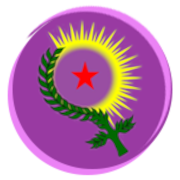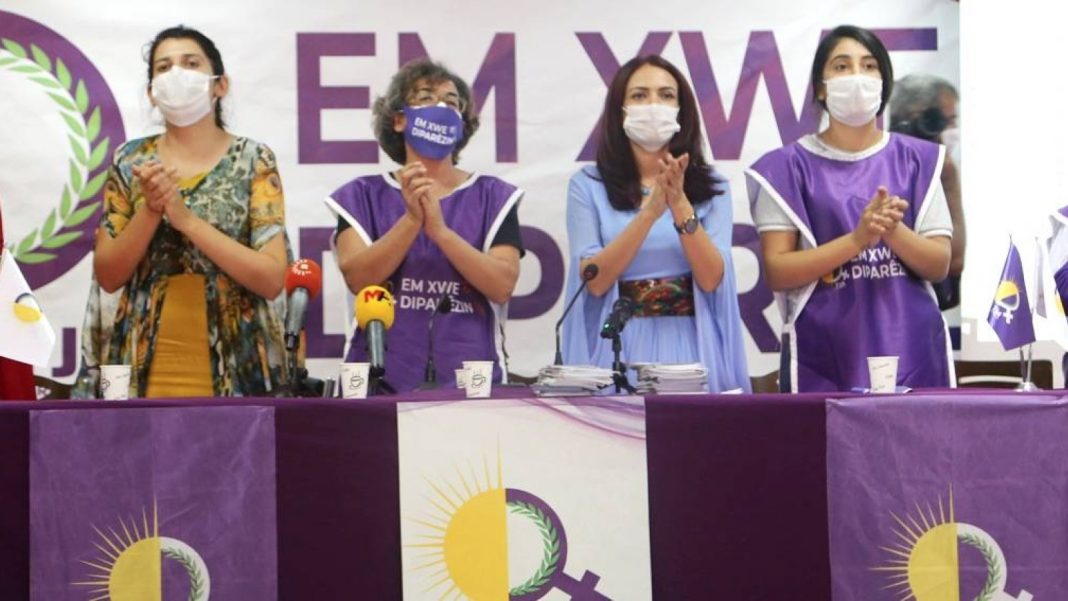Kurdish Women’s Movement in Northern Kurdistan
Kurdish women have always been in struggle in Northern Kurdistan. Until the years when they established their own self-organization, they took part in revolts, resistances and popular uprisings throughout history. Kurdish women also took their place in the uprisings and resistances against the massacres of regional and international powers. However, before the experience of the last 30 years of struggle, their presence in these struggles remained at a level that could be expressed in individual outbursts. Again, an organized women’s stance is not encountered in any rebellion or uprising. The wives of the leaders of the rebellion display a rebellious stance by standing honorably next to their husbands. But they are limited to this. The process in which women themselves began to organize themselves and took their level of organization to the highest level began with the last Kurdish rebellion, the movement started by the ‘Partiya Karkerên Kurdistan’ [Kurdistan Worker’s Party, PKK] which was founded in 1978.
The women who were part of the core group that founded the PKK under the leadership of Abdullah Öcalan increased in quantity and quality in parallel with the developments as the struggle grew. By the 1990s, Kurdish women were organized in the form of associations, groups and associations. The Kurdish women’s movement, linked to the national struggle in Turkey and Northern Kurdistan, began to take shape and grew rapidly from these years onward, and gradually gained strength.
In the 1990s, Kurdish women were affected the most by the state of emergency policies implemented in Kurdistan with the intensification of war, torture and bans in Kurdistan. However, this situation also triggered women’s efforts to raise awareness and organize themselves. The increasing repression of the state led to popular uprisings, which developed a spirit of mobilization and spread from all parts of Kurdistan to Europe, from the mountains to the cities. In this respect, these were years in which the mass awakening, consciousness and organization of the Kurdish people, including women, developed in many ways and embraced the freedom movement.
It can be said that the participation in the freedom movement has increased a lot since the 90s and the majority of them are women. The revolutionary energy of the women in Kurdistan has started to be channeled into different organizational mechanisms. In this regard, the next developments can be evaluated through two channels. The first one is the organizational process of the Kurdistan Women’s Freedom Movement, which was created by the guerrilla women in the mountains, and the second one is the process of the Kurdish women in Northern Kurdistan who organized themselves in political parties, associations, women’s institutions, etc. and gradually developed their mechanisms and united under the umbrella of the ‘Demokratik Özgür Kadın Hareketi’ (Democratic Free Women’s Movement, DÖKH), then the ‘Kongreya Jinên Azad’ (Congress of Free Women, KJA) and finally the ‘Tevgera Jinên Azad’ (Free Women’s Movement, TJA).
With the popular uprisings in the early 90s, especially in North Kurdish cities of Nisêbîn [Turkish name Nusaybin] and Cizîr [Turkish name Cizre], women became increasingly conscious in their fight against denial, oppression and persecution. They increased their fight for rights, law and justice against state fascism and began to lead the society with the slogan ‘Liberated woman liberating society’. Kurdish women who were forcibly displaced from their villages in the metropolises of Turkey have begun to take an active part in politics, cultural centers, newspapers and independent women’s institutions and have begun to organize themselves.
On the other hand, in these years, they also adopted important responsibilities in political parties that prioritized the solution of the Kurdish question. While these parties expressed the Kurds’ search for a solution through democratic political means, they became the centers through which women’s mass resistance was channeled. However, aside from these developments, we cannot yet speak of a unique-autonomous women’s organization in this period. Even though the programs of these political parties emphasized the equality of men and women and planned women’s free participation in social life, they could not be addressed at the level of an own organization.
Starting in these years, Kurdish women have continuously participated in the political journey that started with the ‘Halkın Emek Partisi’ (People’s Labor Party, HEP), ‘Demokrasi Partisi (Democracy Party, DEP), ‘Özgürlük ve Demokrasi Partisi’ (Freedom and Democracy Party, ÖZDEP), ´Halkın Demokrasi Partisi’ (People’s Democracy Party, HADEP), ‘Demokratik Halk Partisi’ (Democratic People’s Party, DEHAP), ‘Demokratik Toplum Partisi’ (Democratic Society Party, DTP), ‘Barış ve Demokrasi Partisi’ (Peace and Democracy Party, BDP) and finally ‘Halkların Demokratik Partisi’ (Peoples’ Democratic Party, HDP) and ‘Demokratik Bölgeler Partisi’ (Democratic Regions Party, DBP). Throughout these processes, they have gone through many stages until the ‘Demokratik Özgür Kadın Hareketi’ (Democratic Free Women’s Movement, DÖKH), the first concrete original organization in 2005.
Indeed, from commissions to branches, from quotas to the co-chairmanship system, the unique organization of women in parliament and local politics has continuously grown and developed in terms of quantity and quality.
Although there have been developments in these periods, it has of course not been easy to overcome the male mentality within the political parties and institutions they struggle for. In all these processes, women organized in women’s branches were not only limited to struggling against the men within the party, but also took part intensively in mass organizing activities and strived for the solution of social problems such as violence against women, rape, abduction, forced marriage, dowry, etc.
However, as often experienced in the world, the conditions of being Kurdish and a woman brought both state-based oppression and violence and physical and psychological attacks from men. But the women’s struggle has always moved forward.
Concretely, it can be stated that during the DTP period, after Kurdish women entered parliament in 2007, the women’s liberation struggle was brought to parliament. The fact that each of the women MPs came from a dynamic struggle also resulted in the representation of many areas of struggle in parliament. In this respect, in a way, we can talk about the representation of all the areas in which women existed in the women’s liberation struggle.
During the periods mentioned above, another premiere was achieved in Turkish politics: the co-presidency system was implemented de facto even though there was no legal basis for it, and a petition campaign was organized to change the relevant laws that prevented the implementation of this system and nearly 500 thousand signatures were delivered to the relevant institutions.
Since 2007, the Kurdish women’s movement in Northern Kurdistan and Turkey has started to implement and enforce the principle of equal representation and participation in the political and social sphere step by step, first at the level of co-presidency and then through the overcoming of gender quotas. The achievements in this field were not limited to Kurdish women, but were also adopted by many left-socialist-democratic organizations and parties. With the 2014 local elections, the co-presidency model started to be implemented in municipalities. In addition, although women had an equal number of candidates in all electoral lists, the women’s movement determined the candidates.
With the successes achieved in the field of local governance, the number of women’s institutions in provincial and district centers has increased, and women who are politically equipped with women’s consciousness are already working in all fields. Undoubtedly, at no other time in Turkey’s history has any party, institution or association reflected the color of women to such an extent in politics and all social spheres and made women the subject to such an extent.
Thus, a more comprehensive institutionalization became necessary for the women’s organization that gained momentum in 2003. As a result of this necessity, organizing as a movement came to the agenda. As a result of these discussions, in the first stage, the women’s branches of the then DEHAP decided to come together with the mayors of DEHAP and all the women organized in the political field, as well as Kurdish women organized in other fields and women’s institutions, and activists engaged in the struggle for women’s freedom on an individual level, to form the Democratic Free Women’s Movement, which would play the role of an umbrella organization. With this decision, the DÖKH was declared and a council was formed at its first conference. It was decided that this assembly would be responsible for the unification and coordination of Kurdish women in all fields of work and for implementing joint decisions.
The DÖKH has placed the ecological problem, the problem of women freedom and the economic problem at the center of its model and has produced solutions. The fields of activity and institutional work of Kurdish women united under the umbrella of the DÖKH gradually increased until 2015.
In 2015, in order to be more responsive to the developing and growing struggle, DÖKH was dissolved and the establishment of the umbrella organization of Kurdish women, KJA was founded.
While KJA continued its struggle to build the women’s system with the approach of ‘There should not be a single woman without an organization’, it was shut down in 2016 with a Decree Law within the scope of the State of Emergency practices. The Kurdish Women’s Movement then decided to continue with the TJA without giving up on the KJA system ideologically and continued its struggle with the organization that exists until today.
It can be said that the answer to the question of how Kurdish women reached their current political position and public visibility lies in the ethno-political historical experience. As an example, the violations of rights that Kurdish womenwere subjected to during and after the September 12 military coup and the phenomenon of violence that affected daily life as a whole constitute, one of the starting points is this experience. Because the provinces of Northern Kurdistan are the places where the highest number of detentions and arrests took place on September 12 and afterwards where violations of rights and violence in prison were the most intense. In this period, Kurdish women primarily gained public visibility with their national identity rather than their own identity as women. By the 1990s, the extent of the state of emergency, unsolved murders, disappearances and state fascism as a whole, and the popular uprisings that took place, made Kurdish women more visible and organized as they started an organized struggle and started to struggle for their rights in the public sphere with exemplary organizations such as the Saturday Mothers or the Mothers of the Disappeared and the Mothers of Peace.
Kurdish women today continue to struggle with the paradigm of organized and democratic modernity in every field, from parliament to local governments, with women’s institutions everywhere, with the co-presidency system in the struggle in general, despite the increasing fascist oppression, especially in recent years. Young girls of all ages, of all colors, from all social classes, mothers, all women continue to grow their organization for the women’s revolution.

